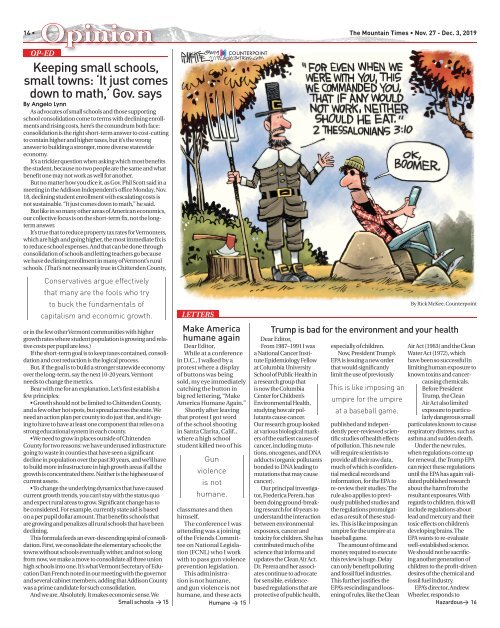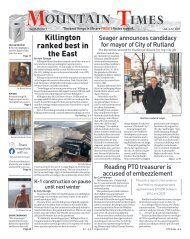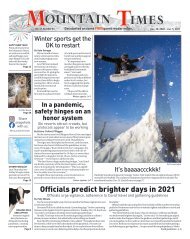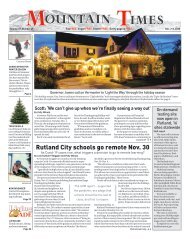Mountain Times - Volume 48, Number 48: Nov. 27-Dec. 3, 2019
Create successful ePaper yourself
Turn your PDF publications into a flip-book with our unique Google optimized e-Paper software.
Opinion<br />
14 • The <strong>Mountain</strong> <strong>Times</strong> • <strong>Nov</strong>. <strong>27</strong> - <strong>Dec</strong>. 3, <strong>2019</strong><br />
OP-ED<br />
Keeping small schools,<br />
small towns: ‘It just comes<br />
down to math,’ Gov. says<br />
By Angelo Lynn<br />
As advocates of small schools and those supporting<br />
school consolidation come to terms with declining enrollments<br />
and rising costs, here’s the conundrum both face:<br />
consolidation is the right short-term answer to cost-cutting<br />
to contain higher and higher taxes, but it’s the wrong<br />
answer to building a stronger, more diverse statewide<br />
economy.<br />
It’s a trickier question when asking which most benefits<br />
the student, because no two people are the same and what<br />
benefit one may not work as well for another.<br />
But no matter how you dice it, as Gov. Phil Scott said in a<br />
meeting in the Addison Independent’s office Monday, <strong>Nov</strong>.<br />
18, declining student enrollment with escalating costs is<br />
not sustainable. “It just comes down to math,” he said.<br />
But like in so many other areas of American economics,<br />
our collective focus is on the short-term fix, not the longterm<br />
answer.<br />
It’s true that to reduce property tax rates for Vermonters,<br />
which are high and going higher, the most immediate fix is<br />
to reduce school expenses. And that can be done through<br />
consolidation of schools and letting teachers go because<br />
we have declining enrollment in many of Vermont’s rural<br />
schools. (That’s not necessarily true in Chittenden County,<br />
Conservatives argue effectively<br />
that many are the fools who try<br />
to buck the fundamentals of<br />
capitalism and economic growth.<br />
LETTERS<br />
Make America<br />
humane again<br />
Dear Editor,<br />
While at a conference<br />
in D.C., I walked by a<br />
protest where a display<br />
of buttons was being<br />
sold, my eye immediately<br />
catching the button in<br />
big red lettering, “Make<br />
America Humane Again.”<br />
Shortly after leaving<br />
that protest I got word<br />
of the school shooting<br />
in Santa Clarita, Calif.,<br />
where a high school<br />
student killed two of his<br />
or in the few other Vermont communities with higher<br />
growth rates where student population is growing and relative<br />
costs per pupil are less.)<br />
If the short-term goal is to keep taxes contained, consolidation<br />
and cost reduction is the logical process.<br />
But, if the goal is to build a stronger statewide economy<br />
over the long-term, say the next 10-20 years, Vermont<br />
needs to change the metrics.<br />
Bear with me for an explanation. Let’s first establish a<br />
few principles:<br />
• Growth should not be limited to Chittenden County,<br />
and a few other hot spots, but spread across the state. We<br />
need an action plan per county to do just that, and it’s going<br />
to have to have at least one component that relies on a<br />
strong educational system in each county.<br />
• We need to grow in places outside of Chittenden<br />
County for two reasons: we have underused infrastructure<br />
going to waste in counties that have seen a significant<br />
decline in population over the past 30 years, and we’ll have Gun<br />
to build more infrastructure in high growth areas if all the<br />
growth is concentrated there. Neither is the highest use of<br />
violence<br />
current assets.<br />
is not<br />
• To change the underlying dynamics that have caused<br />
current growth trends, you can’t stay with the status quo humane.<br />
and expect rural areas to grow. Significant change has to<br />
be considered. For example, currently state aid is based classmates and then<br />
on a per pupil dollar amount. That benefits schools that himself.<br />
are growing and penalizes all rural schools that have been The conference I was<br />
declining.<br />
attending was a joining<br />
This formula feeds an ever-descending spiral of consolidation.<br />
First, we consolidate the elementary schools; the tee on National Legisla-<br />
of the Friends Commit-<br />
towns without schools eventually wither, and not so long tion (FCNL) who I work<br />
from now, we make a move to consolidate all three union with to pass gun violence<br />
high schools into one. It’s what Vermont Secretary of Education<br />
Dan French noted in our meeting with the governor This administra-<br />
prevention legislation.<br />
and several cabinet members, adding that Addison County tion is not humane,<br />
was a prime candidate for such consolidation.<br />
and gun violence is not<br />
And we are. Absolutely. It makes economic sense. We humane, and these acts<br />
Small schools > 15 Humane > 15<br />
By Rick McKee, Counterpoint<br />
Trump is bad for the environment and your health<br />
Dear Editor,<br />
From 1987–1991 I was<br />
a National Cancer Institute<br />
Epidemiology Fellow<br />
at Columbia University<br />
School of Public Health in<br />
a research group that<br />
is now the Columbia<br />
Center for Children’s<br />
Environmental Health,<br />
studying how air pollutants<br />
cause cancer.<br />
Our research group looked<br />
at various biological markers<br />
of the earliest causes of<br />
cancer, including mutations,<br />
oncogenes, and DNA<br />
adducts (organic pollutants<br />
bonded to DNA leading to<br />
mutations that may cause<br />
cancer).<br />
Our principal investigator,<br />
Frederica Perera, has<br />
been doing ground-breaking<br />
research for 40 years to<br />
understand the interaction<br />
between environmental<br />
exposures, cancer and<br />
toxicity for children. She has<br />
contributed much of the<br />
science that informs and<br />
updates the Clean Air Act.<br />
Dr. Perera and her associates<br />
continue to advocate<br />
for sensible, evidencebased<br />
regulations that are<br />
protective of public health,<br />
especially of children.<br />
Now, President Trump’s<br />
EPA is issuing a new order<br />
that would significantly<br />
limit the use of previously<br />
This is like imposing an<br />
umpire for the umpire<br />
at a baseball game.<br />
published and independently<br />
peer-reviewed scientific<br />
studies of health effects<br />
of pollution. This new rule<br />
will require scientists to<br />
provide all their raw data,<br />
much of which is confidential<br />
medical records and<br />
information, for the EPA to<br />
re-review their studies. The<br />
rule also applies to previously<br />
published studies and<br />
the regulations promulgated<br />
as a result of these studies.<br />
This is like imposing an<br />
umpire for the umpire at a<br />
baseball game.<br />
The amount of time and<br />
money required to execute<br />
this review is huge. Delay<br />
can only benefit polluting<br />
and fossil fuel industries.<br />
This further justifies the<br />
EPA’s rescinding and loosening<br />
of rules, like the Clean<br />
Air Act (1963) and the Clean<br />
Water Act (1972), which<br />
have been so successful in<br />
limiting human exposure to<br />
known toxins and cancercausing<br />
chemicals.<br />
Before President<br />
Trump, the Clean<br />
Air Act also limited<br />
exposure to particularly<br />
dangerous small<br />
particulates known to cause<br />
respiratory distress, such as<br />
asthma and sudden death.<br />
Under the new rules,<br />
when regulations come up<br />
for renewal, the Trump EPA<br />
can reject these regulations<br />
until the EPA has again validated<br />
published research<br />
about the harm from the<br />
resultant exposures. With<br />
regards to children, this will<br />
include regulations about<br />
lead and mercury and their<br />
toxic effects on children’s<br />
developing brains. The<br />
EPA wants to re-evaluate<br />
well-established science.<br />
We should not be sacrificing<br />
another generation of<br />
children to the profit-driven<br />
desires of the chemical and<br />
fossil fuel industry.<br />
EPA’s director, Andrew<br />
Wheeler, responds to<br />
Hazardous> 16

















